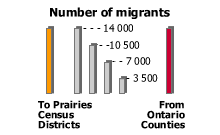|
|
||||||
Area units: Data units: |
 |
Number of migrants |
 |
Origins of Ontario migrants |
 |
Destinations of Ontario migrants |
 |
This layer shows Ontario counties and migrants to the prairies. The bars for number of migrants can be turned off or on. This is an active layer. See explanation in Active Tools below. |
|
This layer shows Census Divisions on the Prairies and migrants from Ontario to them. The bars for number of migrants can be turned off or on. This is an active layer. See explanation in Active Tools below. |
|
This layer shows Modern Geography (current provincial and territorial boundaries, as well as selected cities), and is available for reference. |
 |
This is an active layer, when the ONTARIO COUNTIES 1901 layer name is highlighted in yellow. Only one layer can be active at a time. Use the tools below to get data about the migrants from Ontario counties in this layer. |
| This is an active layer, when the PRAIRIES CDS 1911 layer name is highlighted in yellow. Only one layer can be active at a time. Use the tools below to get data about the migrants from Ontario to these CDs in this layer. | |
Identify: Click on the Identify tool, then click on the map on one of the vertical bars, to pop up a box showing the total migrants from that Ontario county, or to that Prairie CD. |
|
Table: Click on the Table tool, then click or drag a rectangle on the map across one or more counties or CDs, to select them and pop up a table showing information about Ontario migrants from or to them. See Table Fields below. |
| COUNTY | County or group of counties or comparable area, defined as origin for migrants |
| PROVINCE | Province of origin - always Ontario in this dataset |
| SAMPLE SIZE | Number of migrants in sample - districts of origin were based on a sample of Prairie newspaper obituaries |
| POPULATION 1901 | Population of "County" in 1901 census |
| ESTIMATED MIGRANTS | Estimated total number of migrants from "County" |
| MIGRANTS PER 1000 PEOPLE | Migration rate per 1000 = Estimated migrants / Population 1901 * 1000 |
| CENSUS DIVISION | Prairie Census Division (CD) as defined in 1911 Census of Canada, destination for migrants |
| PROVINCE | Province |
| PERCENT OF ONTARIO MIGRANTS | Percentage of all Ontario migrants coming to this CD during this period |
| ESTIMATED MIGRANTS | Total estimated number of Ontario migrants coming to this CD during this period |
| Extensive data source notes appear in the Authors and Sources page. Please refer to that page for details of data compilation. |